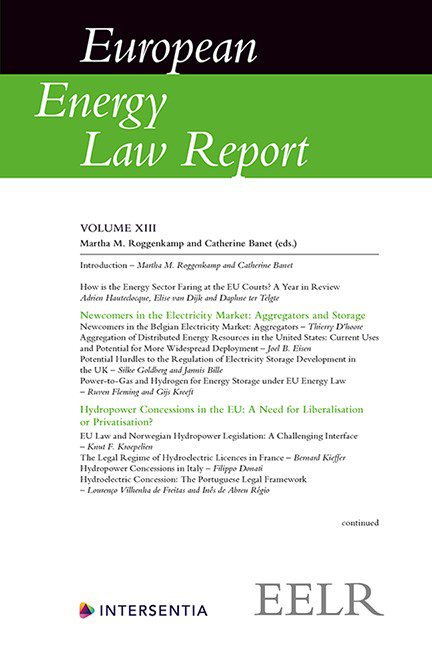Book contents
- Frontmatter
- Preface
- Contents
- List of Abbreviations
- List of Contributors
- Introduction
- Chapter I How is the Energy Sector Faring at the EU Courts? A Year in Review
- PART I NEWCOMERS IN THE ELECTRICITY MARKET: AGGREGATORS AND STORAGE
- PART II HYDROPOWER CONCESSIONS IN THE EU: A NEED FOR LIBERALISATION OR PRIVATISATION?
- PART III INVESTMENTS AND DISINVESTMENTS IN THE ENERGY SECTOR
- PART IV OFFSHORE DECOMMISSIONING IN THE NORTH SEA
- PART V CCS AS A CLIMATE TOOL: NORTH SEA PRACTICE
- PART VI FROM EU CLIMATE GOALS TO NATIONAL CLIMATE LAWS
Chapter XVIII - CCS Legislation in Norway: The EU CCS Directive and its Implementation into Norwegian Law
Published online by Cambridge University Press: 30 April 2020
- Frontmatter
- Preface
- Contents
- List of Abbreviations
- List of Contributors
- Introduction
- Chapter I How is the Energy Sector Faring at the EU Courts? A Year in Review
- PART I NEWCOMERS IN THE ELECTRICITY MARKET: AGGREGATORS AND STORAGE
- PART II HYDROPOWER CONCESSIONS IN THE EU: A NEED FOR LIBERALISATION OR PRIVATISATION?
- PART III INVESTMENTS AND DISINVESTMENTS IN THE ENERGY SECTOR
- PART IV OFFSHORE DECOMMISSIONING IN THE NORTH SEA
- PART V CCS AS A CLIMATE TOOL: NORTH SEA PRACTICE
- PART VI FROM EU CLIMATE GOALS TO NATIONAL CLIMATE LAWS
Summary
INTRODUCTION
Since 1996, carbon dioxide (CO2) has been captured and stored geologically offshore on the Norwegian continental shelf. The first project was at the Sleipner field. Decades of experience from management of hydrocarbons on the continental shelf, combined with the introduction of a high tax on CO2 emissions and sales specifications for gas, incentivized this first carbon capture and storage (CCS) project in Norway, as well as in Europe. Back in 1996, there was no CCS-specific legislation in Norway. The CCS part of the activities on the Sleipner field was regulated through existing pollution and resource management legislation. These regulations do to some extent still apply for CCS activities today. CCS-specific regulations first came into place when Norway implemented in 2014 the European Union Directive 2009/31/EC on the geological storage of carbon dioxide (the CCS Directive).
The chapter starts by presenting the main components of the Norwegian CCS policy, including its objectives and main projects (Section 2).Thereafter, the chapter makes an in-depth descriptive analysis of the content of the CCS Directive (Section 3). The chapter then moves the focus towards the process of implementation of the CCS Directive into Norwegian law and provides an overview of the main pieces of CCS legislation in Norway (Section 4), before ending with some concluding remarks (Section 5).
BACKGROUND ON NORWEGIAN CCS POLICY
CCS AND CCUS
Carbon dioxide capture and geological storage is a range of various technologies allowing capture of carbon dioxide from industrial processes or electricity generation from fossil sources and storing it safely and permanently in geological formations. This prevents the carbon dioxide from entering into the atmosphere. Further, where CCS is applied to an industrial process or electricity/heat generation based on biological material, one can actually achieve a net out-take of carbon dioxide from the atmosphere, so-called “negative emissions”. This is often referred to as BECCS or Bio-CCS, and is one of few known technologies today that can provide negative emissions.
Another common abbreviation is CCUS. Here, potential use of the captured carbon is included, either as an alternative to permanent storage or as a step towards permanent storage.
- Type
- Chapter
- Information
- European Energy Law Report XIII , pp. 369 - 386Publisher: IntersentiaPrint publication year: 2020
- 2
- Cited by

